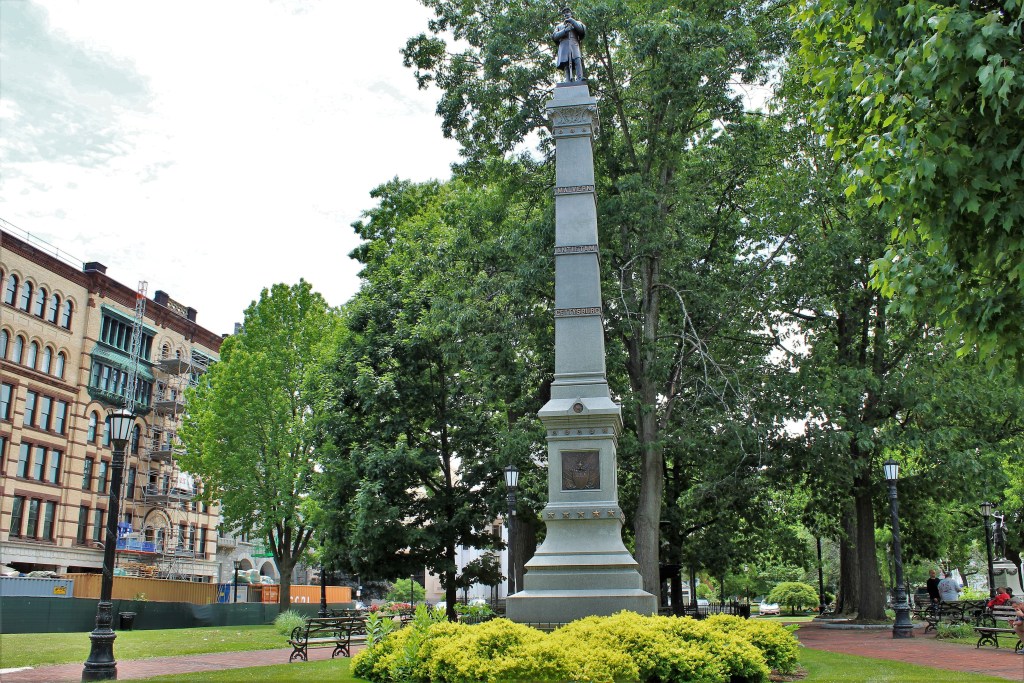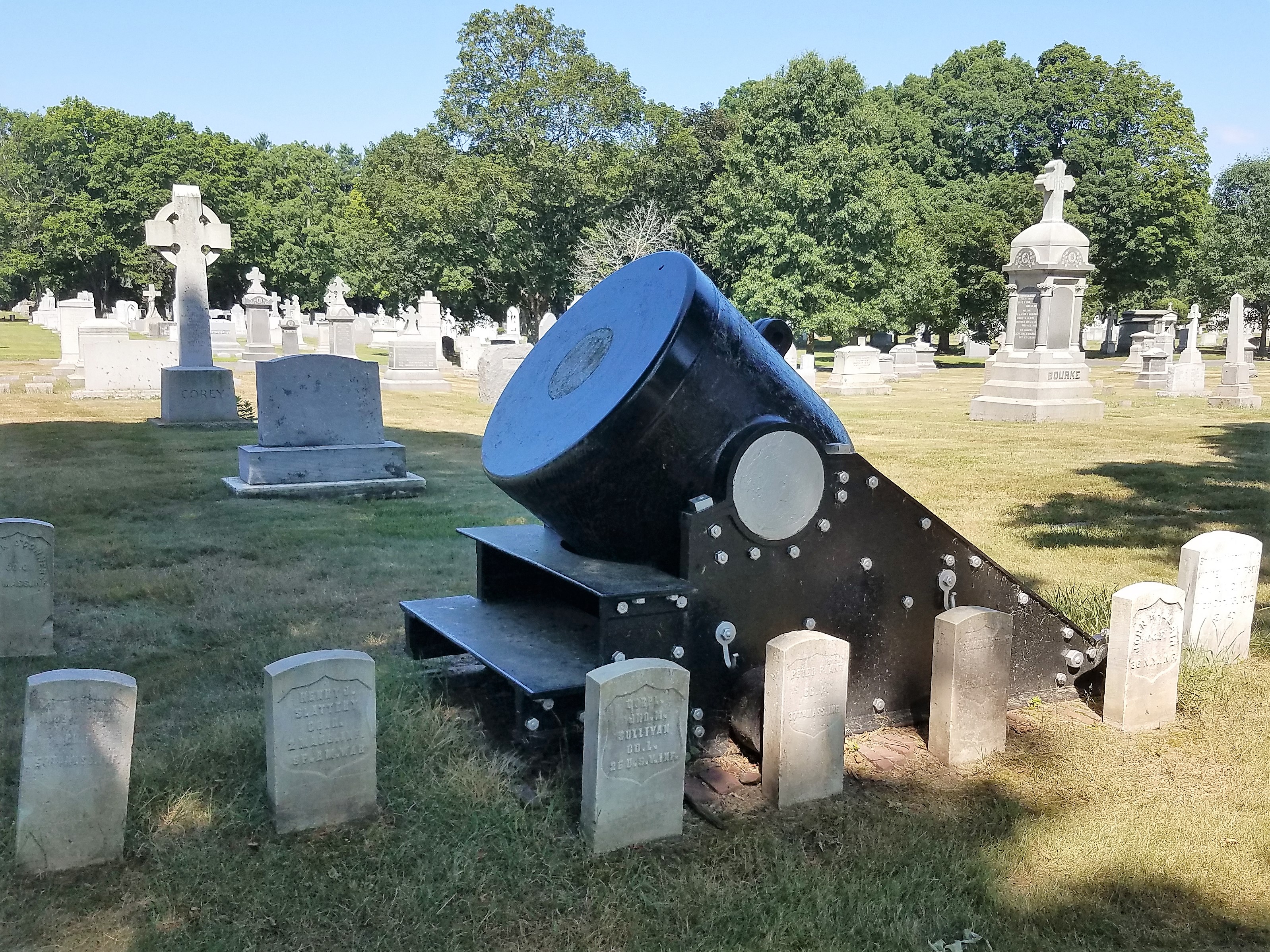
The third-largest city in the Commonwealth has no fewer than four monuments dedicated to those who served in the Civil War. In addition to a city-wide monument in Court Square, some impressive monuments were also placed at the veterans burial plots in at least three cemeteries. The monuments will be discussed here in chronological order.

Springfield Cemetery Monument
Location: 175 Cemetery Avenue, Springfield
Coordinates: 42°06’07.0″N 72°34’32.2″W
Date dedicated: May 31, 1877
Architect/sculptor: Maurice J. Powers, National Fine Art Foundry, New York, casting; Henry J. Ellicott, sculptor
This fine statue, Springfield’s first Civil War monument, stands on the soldier’s plot in Springfield Cemetery were some 200 Civil War veterans are buried.[1] The first version of this statue was originally sculpted by Henry J. Ellicott for the New York City Civil War Monument in Brooklyn and cast at the National Fine Art Foundry in New York. The foundry was owned and managed by sculptor Maurice J. Power. His operation was responsible for numerous Revolutionary War and Civil War memorials around the country. Ellicott’s infantryman, notable for his more casual pose and an arm thrown over the muzzle of his musket, can also be found on monuments in Lawrence and Clinton, Massachusetts. Ellicott also sculpted the “Goddess of Victory” on Holyoke’s monument.
During the war, Springfield citizens organized a “Soldiers’ Rest” in a house near the train depot where returning soldiers could get food, clothing, medical attention, assistance with discharge paperwork, etc. In December 1864, the Soldiers’ Rest Association organized a tremendous fair in Springfield involving thousands of volunteers from the entire region which raised $18,000. This kept the Soldiers’ Rest running and then some. Years later, the unspent remainder of $4,200 was put towards this monument.[2]




Springfield Soldiers’ and Sailors’ Monument
Location: Court Square, 1270 Main Street, Springfield
Coordinates: 42°06’05.0″N 72°35’18.8″W
Date dedicated: September 29, 1885
Architect/sculptor: Design by Melzar H. Mosman; bronze casting by Ames Foundry of Chicopee; granite cutting by F. Hardwick & Sons of Quincy.[3]
This 43 foot tall monument was a gift of Gurdon Bill to the Wilcox Post 16 of the Grand Army of the Republic which in turn gave the monument over to the city. Bill was one of the city’s wealthiest residents, a book publisher who became the President of the Springfield & New London Railroad Company and also had interests in several other businesses including the Springfield Knitting Company.[4] It is relatively rare for a large city monument such as this one to be funded by a single individual.
Roughly 2,000 veterans from the region took part in the dedication procession, a remarkable number.[5] The dedication address was given by General Joseph R. Hawley of Hartford. A major figure in Connecticut’s role in the Civil War, General Hawley was a much sought after speaker for dedication exercises. His Springfield address was one of his longest. He made only passing references to slavery and emancipation and instead focused on the importance of American democracy and the notion that world civilization would have been set back a century if the republic had failed.[6]
The text of one of the plaques is worthy of reprinting here not only for the facts but also the tone: “Springfield furnished in the war of the rebellion two thousand four hundred and eighty five soldiers and sailors, the greater part of of whom enlisted in the 10th, 27th, 37th, and 46th regiments. They served with credit and honor and the survivors, returning to the walks of peaceful life, cherishing the memory of their comrades who fell, dedicate this monument to perpetuate their memory amid the homes they died to save. May the memory of the patriot dead be the inspiration of posterity.” This particular take on the northern role in the war as a defense of hearth and home is unusual for a Massachusetts monument. The destruction of slavery or even saving the Union is not mentioned.
The statue atop the column was produced by the Ames Foundry in Chicopee for several other Massachusetts monuments including Northampton and Kingston. It was likely inspired by Ellicott’s earlier statue, depicted above.





St. Michael’s Cemetery Mortar
Location: 20 Boston Road, Springfield
Coordinates: 42°07’20.9″N 72°32’17.6″W
Date dedicated: December 1900
This tremendous 13-inch mortar weighs approximately 20,000 pounds and was produced at the Fort Pitt Foundry in Pennsylvania in 1862. A mortar is also used as a memorial in Spencer, however this one is many times larger. Mortars of this size fired a projectile that weighed 200 pounds. It was a gift of the United States government to the city of Springfield, sent from the Portsmouth Navy Yard in New Hampshire. The city, already having cannons in the Springfield cemetery and other locations, gave the mortar to St. Michael’s Cemetery to adorn the veteran’s plot there. This, according to the Springfield Republican, was “in acknowledgement of the fact that many veterans are buried there.”[7] It is the only known Civil War memorial in the Commonwealth placed in a Catholic cemetery.[8]



Oak Grove Cemetery Monument
Location: 450 Bay Street, Springfield
Coordinates: 42°07’18.5″N 72°33’59.9″W
Date dedicated: c. 1910
Architect/sculptor: Unknown
Information is scarce on Springfield’s last monument honoring her Civil War dead. According to the Grand Army of the Republic Post Commander in 1910, this monument was erected by the Wilcox Post 16 in Springfield to mark the veterans plot in Oak Grove Cemetery. As of 1910 it was not yet dedicated.[9] The sculptor and manufacturer are presently unknown.
[1] Springfield Cemetery, “Historic Grave Sites“
[2] Alfred S. Roe, Monuments, Tablets and Other Memorials Erected in Massachusetts to Commemorate the Service of her Sons in the War of the Rebellion, 1861-1865, (Boston: Wright and Potter Printers, 1910), 108.
[3] “The Literary Exercises. Giving the Monument,” Springfield Republican, September 30, 1885.
[4] Samuel Atkins Eliot, “Gurdon Bill,” Biographical History of Massachusetts, (Boston: Massachusetts Biographical Society, 1913), volume 4.
[5] “Springfield’s Gala Day, Dedication of the Soldiers’ Monument,” Boston Journal, September 29, 1885, 1.
[6] Matthew Warshauer, Connecticut in the American Civil War: Slavery, Sacrifice, and Survival, (Middletown, CT: Wesleyan University Press, 2011), 206-207.
[7] Springfield Republican, December 31, 1900, 10.
[8] Roe, 108.
[9] Roe, 108.